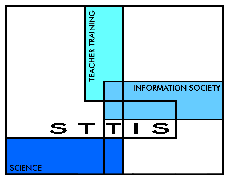
Science Teacher Training
in an Information Society
 Teaching about energy
Teaching about energy

 |
Science Teacher Training
in an Information Society |
 |
Workshop 1
|
Aims
BackgroundA very common way in which energy is dealt with in school textbooks is the ‘forms of energy’ approach. Energy is introduced as existing in different forms (e.g. heat energy, electrical energy, sound energy). Energy may be converted from one form to another during the course of a change. In some approaches it is suggested that it is the conversion of one form of energy to another is the cause for the change to happen. A popular way of introducing this idea of energy ‘transformation’ is through the use of an ‘energy circus’, in which pupils identify the energy changes taking place in a variety of different phenomena. Though this approach is popular, the National Curriculum has never referred to ‘forms of energy’ in any of its various versions since it was first introduced. Many people have argued that the forms of energy approach raises a number of difficulties.In this activity you will first look at a energy circus as if you were a pupil doing the activity, writing down the energy changes taking place. You will then begin to consider some of the difficulties with the approach. What to do1. The table on page 2 shows some apparatus commonly used in an ‘energy circus’. Look at the questions on this sheet and write the answers on the table.2. How many different ‘forms of energy’ did you identify? Is this a ‘complete set’ of different forms of energy, or are there others that are not included? Did different people in the group agree about the forms identified? 3. Some people might say that ‘chemical energy’ is too abstract, and that it is better to associate forms of energy more directly with the things that contain the energy. Do you think that it helps to have terms such as ‘food energy’ and ‘fuel energy’. What about ‘bread energy’ and ‘cheese energy’? Does the term ‘muscle energy’ help to explain what happens during physical activity. 4. Some books illustrate ‘forms of energy’ with objects. For example, chemical energy might be illustrated by a can of petrol, and electrical energy by a torch battery. Is this helpful? 5. A lamp uses electricity and it produces
light. How does it add to our understanding to say, for example, that it
converts electrical energy into light energy? Or is the word ‘energy’ just
a ‘verbal ornament’?
|
| <<= Previous page | Introduction to Teachers' Workshop 1 | Next page =>> |